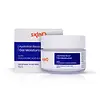What's inside
What's inside
 Key Ingredients
Key Ingredients

 Benefits
Benefits

 Concerns
Concerns

 Ingredients Side-by-side
Ingredients Side-by-side

Water
Skin ConditioningGlycerin
HumectantPentylene Glycol
Skin ConditioningPanthenol
Skin ConditioningSodium Hyaluronate
HumectantHydrolyzed Sodium Hyaluronate
Skin ConditioningSodium Acetylated Hyaluronate
HumectantSodium Hyaluronate Crosspolymer
HumectantCaprylyl Methicone
Skin ConditioningPEG-12 Dimethicone
Skin ConditioningDimethicone
EmollientCyclopentasiloxane
EmollientPolyacrylamide
C13-14 Isoparaffin
EmollientLaureth-7
EmulsifyingGlyceryl Acrylate/Acrylic Acid Copolymer
HumectantPvm/Ma Copolymer
Emulsion StabilisingPEG-Crosspolymer
PEG/PPG-18/18 Dimethicone
EmulsifyingTrideceth-6
EmulsifyingDimethyl Ether
SolventWater, Glycerin, Pentylene Glycol, Panthenol, Sodium Hyaluronate, Hydrolyzed Sodium Hyaluronate, Sodium Acetylated Hyaluronate, Sodium Hyaluronate Crosspolymer, Caprylyl Methicone, PEG-12 Dimethicone, Dimethicone, Cyclopentasiloxane, Polyacrylamide, C13-14 Isoparaffin, Laureth-7, Glyceryl Acrylate/Acrylic Acid Copolymer, Pvm/Ma Copolymer, PEG-Crosspolymer, PEG/PPG-18/18 Dimethicone, Trideceth-6, Dimethyl Ether
Water
Skin ConditioningCaprylic/Capric Triglyceride
MaskingGlycerin
HumectantGlyceryl Stearate
EmollientPEG-100 Stearate
Cetyl Alcohol
EmollientCetearyl Olivate
Sorbitan Olivate
EmulsifyingDimethicone
EmollientDimethicone Crosspolymer
Emulsion StabilisingCyclopentasiloxane
EmollientHyaluronic Acid
HumectantLaminaria Digitata Extract
Skin ProtectingCetyl-Pg Hydroxyethyl Palmitamide
Skin ConditioningCeramide EOP
Skin ConditioningCeramide Ns
Skin ConditioningCeramide NP
Skin ConditioningCeramide As
Skin ConditioningCeramide AP
Skin ConditioningTocopheryl Acetate
AntioxidantPolyglutamic Acid
Skin ConditioningLactobacillus
Skin ConditioningMaltodextrin
AbsorbentOryza Sativa Bran Water
MaskingCocos Nucifera Oil
MaskingOlea Europaea Fruit Oil
MaskingSimmondsia Chinensis Seed Oil
EmollientStearic Acid
CleansingSodium Polyacrylate
AbsorbentDicaprylyl Carbonate
EmollientPolyglyceryl-3 Caprate
EmulsifyingXylitylglucoside
HumectantAnhydroxylitol
HumectantXylitol
HumectantBHT
AntioxidantSodium Hydroxide
BufferingXanthan Gum
EmulsifyingDisodium EDTA
C14-22 Alcohols
Emulsion StabilisingC12-20 Alkyl Glucoside
EmulsifyingBenzyl Alcohol
PerfumingEthylhexylglycerin
Skin ConditioningTocopherol
AntioxidantWater, Caprylic/Capric Triglyceride, Glycerin, Glyceryl Stearate, PEG-100 Stearate, Cetyl Alcohol, Cetearyl Olivate, Sorbitan Olivate, Dimethicone, Dimethicone Crosspolymer, Cyclopentasiloxane, Hyaluronic Acid, Laminaria Digitata Extract, Cetyl-Pg Hydroxyethyl Palmitamide, Ceramide EOP, Ceramide Ns, Ceramide NP, Ceramide As, Ceramide AP, Tocopheryl Acetate, Polyglutamic Acid, Lactobacillus, Maltodextrin, Oryza Sativa Bran Water, Cocos Nucifera Oil, Olea Europaea Fruit Oil, Simmondsia Chinensis Seed Oil, Stearic Acid, Sodium Polyacrylate, Dicaprylyl Carbonate, Polyglyceryl-3 Caprate, Xylitylglucoside, Anhydroxylitol, Xylitol, BHT, Sodium Hydroxide, Xanthan Gum, Disodium EDTA, C14-22 Alcohols, C12-20 Alkyl Glucoside, Benzyl Alcohol, Ethylhexylglycerin, Tocopherol
 Reviews
Reviews

Ingredients Explained
These ingredients are found in both products.
Ingredients higher up in an ingredient list are typically present in a larger amount.
Cyclopentasiloxane, or D5, is a silicone used to improve texture of products and trap moisture.
D5 is considered lightweight and volatile. Volatile means it evaporates quickly after application. Once evaporated, D5 leaves a thin barrier that helps keep skin hydrated.
It is also an emollient. Emollients help soften the skin and prevent water loss. Silicones create a silky texture in products. D5 helps other ingredients become more spreadable.
Studies show D5 is safe to use in skincare products. We recommend speaking with a skincare professional if you have concerns.
Learn more about CyclopentasiloxaneDimethicone is a type of synthetic silicone created from natural materials such as quartz.
What it does:
Dimethicone comes in different viscosities:
Depending on the viscosity, dimethicone has different properties.
Ingredients lists don't always show which type is used, so we recommend reaching out to the brand if you have questions about the viscosity.
This ingredient is unlikely to cause irritation because it does not get absorbed into skin. However, people with silicone allergies should be careful about using this ingredient.
Note: Dimethicone may contribute to pilling. This is because it is not oil or water soluble, so pilling may occur when layered with products. When mixed with heavy oils in a formula, the outcome is also quite greasy.
Learn more about DimethiconeGlycerin is already naturally found in your skin. It helps moisturize and protect your skin.
A study from 2016 found glycerin to be more effective as a humectant than AHAs and hyaluronic acid.
As a humectant, it helps the skin stay hydrated by pulling moisture to your skin. The low molecular weight of glycerin allows it to pull moisture into the deeper layers of your skin.
Hydrated skin improves your skin barrier; Your skin barrier helps protect against irritants and bacteria.
Glycerin has also been found to have antimicrobial and antiviral properties. Due to these properties, glycerin is often used in wound and burn treatments.
In cosmetics, glycerin is usually derived from plants such as soybean or palm. However, it can also be sourced from animals, such as tallow or animal fat.
This ingredient is organic, colorless, odorless, and non-toxic.
Glycerin is the name for this ingredient in American English. British English uses Glycerol/Glycerine.
Learn more about GlycerinWater. It's the most common cosmetic ingredient of all. You'll usually see it at the top of ingredient lists, meaning that it makes up the largest part of the product.
So why is it so popular? Water most often acts as a solvent - this means that it helps dissolve other ingredients into the formulation.
You'll also recognize water as that liquid we all need to stay alive. If you see this, drink a glass of water. Stay hydrated!
Learn more about Water